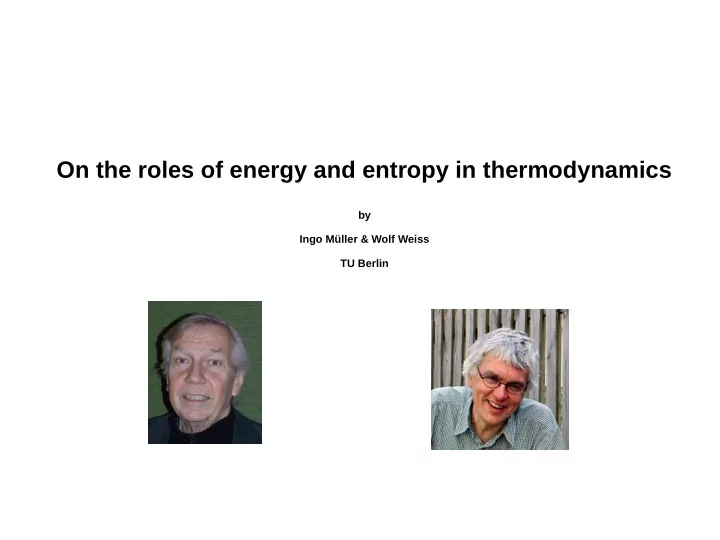

On the roles of energy and entropy in thermodynamics by Ingo Müller & Wolf Weiss TU Berlin
T q J.B. Fourier i x i v v t 2 i l ij ij x x j l G. G. Stokes C.-L. Navier Derivations did not require the knowledge of the nature of heat, let alone the concepts of energy and entropy
dE Q W First Law: dt R. J. Mayer H. v. Helmholtz J. P. Joule dS Q Second Law: dt T 0 S. Carnot R. Clausius S k ln W L. Boltzmann probabilistic interpretation A E T S Minimum in equilibriu m ===► 0 Minimal energy is conducive to equilibrium and so is maximal entropy. Temperature is control parameter. Competition between determinism by which energy approaches a minimum and stochasticity by which entropy approaches a maximum.
Planetary Atmospheres Energy of atmosphere is minimal when all air molecules lie on the solid surface. Who wins? Entropy is maximal when air molecules are evenly distributed throughout space.. M Mercury and Moon have already lost their atmospheres R Relevant parameter k Jupiter, Saturn and Uranus have kept even light gases T Earth hangs on to oxygen and nitrogen – for he the time being !
Osmosis Pfeffer tube W. Pfeffer
Phase Diagrams ( for alloys and solutions)
Ammonia Synthesis (Haber-Bosch) kJ H N NH h 3 h h 2 h 92 . 4 2 2 3 3 H N 2 NH mol 2 2 3 J H N NH s 3 s s s 178 . 6 2 2 3 mol K F. Haber K. Bosch
Doctrine of Forces and Fluxes (TIP) ds 1 du p d dc g Gibbs equation 2 dt T dt dt dt energy mass partial mass balance balance balance q g J i i ds Entropy Inequality 1 dt x T i g 1 n v v 1 1 1 1 T T a a i l g q J t t p 0 i i ij ii T x x T x T 3 x a 1 1 i i i l Thus follows a semi systematic derivation for the laws of Fourier, Navier-Stokes and Fick by linear relations between forces and fluxes. Fully satisfactory for liquids and dense gases. But deficient when rates of change are rapid and gradients are steep as may easily happen in rarefied gases
Extended Thermodynamics u (α=1,2, ...N) Fields i F ( u ) u Solutions: Thermodynamic processes ( u ) Field equation t x i i h ( u ) h for all thermodynamic processes and concave Entropy Principle ( u ) 0 t x i i h ( u ) i h u F u ( x , t ) 0 for all fields i t x t x i i 2 2 i h h u Field equations Change of fields t x i symmetric hyperbolic !! Conclusion: Entropy Principle guarantees that the field equations are symmetric hyperbolic. Initial value problems well-posed: ● existence and uniqueness of solutions ● continuous dependence of solutions on initial data ● finite characteristic speeds
Extended Thermodynamics of 21 Moments (and partial systems) Navier- Euler Stokes Cattaneo Grad´s 13-moment
Heat conduction in the gap between two coaxial cylinders Comparison between Fourier´s law and Grad´s 13-moment theory H. Grad A gas cannot rotate rigidly between the cylinders, if there is heat. A gas between the cylinders cannot be at rest on a turn table, if there is heat flow. c 56 2 T c 1 ln r c 2 1 5 p 75 p k
Light Scattering L. Onsager ET 120, 165, 220, 286 ET is a theory of many theories with only one parameter: The number of fields. For light scattering the theory provides results which are ● satisfactory (because continuum theory works) ● surprising (because theory provides its own limit of applicability) ● disappointing (because so many moments are needed)
Literature Müller,I., Weiss,W. Entropy and Energy, a universal competition. Springer Verlag, Heidelberg (2005) Müller,I., Ruggeri,T. Rational Extended Thermodynamics. Springer Verlag, New York (1998) Müller,I., Weiss,W. Thermodynamics of irreversible processes -- past and present. The European Physical Journal H 37, pp. 139-236 (2012)
Recommend
More recommend